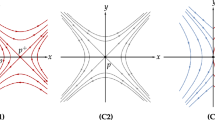Abstract
We provide an integrable discretization of the modified Korteweg–de Vries–sine Gordon equation. The discrete form is a coupled system and is derived via the Cauchy matrix approach by introducing suitable discrete plane wave factors. Solutions and a Lax pair are constructed in this approach. The dynamics of some solutions are illustrated. The modified Korteweg–de Vries–sine Gordon equation is recovered in the continuum limit.


Similar content being viewed by others
Notes
Hereafter, we write \(p\boldsymbol I+\boldsymbol K\) as \(p+\boldsymbol K\), etc., because this causes no confusion.
References
H. D. Wahlquist and F. B. Estabrook, “Bäcklund transformation for solutions of the Korteweg– de Vries equation,” Phys. Rev. Lett., 31, 1386–1390 (1973).
J. Hietarinta, N. Joshi, and F. W. Nijhoff, Discrete Systems and Integrability, Cambridge Univ. Press, Cambridge (2016).
F. W. Nijhoff and H. Capel, “The discrete Korteweg–de Vries equation,” Acta Appl. Math., 39, 133–158 (1995).
F. W. Nijhoff, G. R. W. Quispel, and H. W. Capel, “Direct linearization of nonlinear difference- difference equations,” Phys. Lett. A, 97, 125–128 (1983).
K. Konno, W. Kameyama, and H. Sanuki, “Effect of weak dislocation potential on nonlinear wave propagation in anharmonic crystal,” J. Phys. Soc. Japan, 37, 171–176 (1974).
L. Bianchi, “Sulla trasformazione di Bäcklund per le superficie peeudosferiche,” Rom. Acc. L. Rend. Ser. 5, 1, 3–12 (1892).
H. H. Chen, “General derivation of Bäcklund transformations from inverse scattering problems,” Phys. Rev. Lett., 33, 925–928 (1974).
K. Konno and H. Sanuki, “Bäcklund transformation for equation of motion for nonlinear lattice under weak dislocation potential,” J. Phys. Soc. Japan, 39, 22–24 (1975).
C.-H. Gu, “On the Bäcklund transformations for the generalized hierarchies of compound MKdV–SG equations,” Lett. Math. Phys., 12, 31–41 (1986).
M. J. Ablowitz, D. J. Kaup, A. C. Newell, and H. Segur, “Method for solving the sine-Gordon equation,” Phys. Rev. Lett., 30, 1262–1264 (1973); “Nonlinear-evolution equations in physical significance,” 31, 125–127 (1973).
F. Nijhoff, J. Atkinson, and J. Hietarinta, “Soliton solutions for ABS lattice equations: I. Cauchy matrix approach,” J. Phys. A: Math. Theor., 42, 404005, 34 pp. (2009).
R. Hirota, “Nonlinear partial difference equations III; discrete sine-Gordon equation,” J. Phys. Soc. Japan, 43, 2079–2086 (1977).
S. J. Orfanidis, “Sine-Gordon equation and nonlinear \(\sigma\) model on a lattice,” Phys. Rev. D, 18, 3828–3832 (1978).
V. E. Adler, A. I. Bobenko, and Yu. B. Suris, “Classification of integrable equations on quad- graphs: the consistency approach,” Commun. Math. Phys., 233, 513–543 (2003).
D.-J. Zhang and S.-L. Zhao, “Solutions to ABS lattice equations via generalized Cauchy matrix approach,” Stud. Appl. Math., 131, 72–103 (2013).
D.-D. Xu, D.-J. Zhang, and S.-L. Zhao, “The Sylvester equation and integrable equations: I. The Korteweg–de Vries system and sine-Gordon equation,” J. Nonlinear Math. Phys., 21, 382–406 (2014).
S.-L. Zhao, “A discrete negative AKNS equation: generalized Cauchy matrix approach,” J. Nonlinear Math. Phys., 23, 544–562 (2016).
A. A. Cho, M. Mesfun, and D.-J. Zhang, “A revisit to the ABS H2 equation,” SIGMA, 17, 093, 19 pp. (2021).
S. S. Li, C. Z. Qu, X. X. Yi, and D.-J. Zhang, “Cauchy matrix approach to the SU(2) self-dual Yang–Mills equation,” Stud. Appl. Math., 148, 1703–1721 (2022).
M. Mesfun and S.-L. Zhao, “Cauchy matrix scheme for semidiscrete lattice Korteweg–de Vries-type equations,” Theoret. and Math. Phys., 211, 483–497 (2022).
A. A. Cho, J. Wang, and D.-J. Zhang, “A direct approach to the model of few-optical-cycle solitons beyond the slowly varying envelope approximation,” Math. Methods Appl. Sci., 46, 8518–8531 (2023).
D.-Y. Chen, D.-J. Zhang, and S.-F. Deng, “The novel multi-soliton solutions of the MKdV–sine Gordon equations,” J. Phys. Soc. Japan, 71, 658–659 (2002).
J. J. Sylvester, “Sur l’équation en matrices \(px=xq\),” C. R. Acad. Sci. Paris, 99, 67–71, 115–116 (1884).
H. Leblond and D. Mihalache, “Models of few optical cycle solitons beyond the slowly varying envelope approximation,” Phys. Rep., 523, 61–126 (2013).
S. V. Sazonov, “Superluminal electromagnetic solitons in nonequilibrium media,” Phys. Usp., 44, 631–644 (2001).
A. N. Bugay and S. V. Sazonov, “Faster-than-light propagation of electromagnetic solitons in nonequilibrium medium taking account of diffraction,” J. Opt. B: Quantum Semiclass. Opt., 6, 328–335 (2004).
S. V. Sazonov, “On the propagation of hypersonic solitons in a strained paramagnetic crystal,” JETP, 117, 885–902 (2013).
O. M. Braun and Yu. S. Kivshar, “Nonlinear dynamics of the Frenkel–Kontorova model,” Phys. Rep., 306, 1–108 (1998).
M. L. Rabelo, “On equations which describe pseudospherical surfaces,” Stud. Appl. Math., 81, 221–248 (1989).
Acknowledgments
We are grateful to the referee for the invaluable comments.
Funding
This research was supported by the National Science Foundation of China (grant Nos. 12271334, 12126352, 12126343, and 11875040).
Author information
Authors and Affiliations
Corresponding author
Ethics declarations
The authors declare no conflicts of interest.
Additional information
Prepared from an English manuscript submitted by the author; for the Russian version, see Teoreticheskaya i Matematicheskaya Fizika, 2023, Vol. 217, pp. 329–347 https://doi.org/10.4213/tmf10479.
Appendix: Solution of Eq. (2.1) and (2.3)
We list solutions \((\boldsymbol r,\boldsymbol M)\) of the coupled system (2.1) and (2.3) when \(\boldsymbol K\) is in the canonical form and \(\boldsymbol s\in\mathbb{C}_N\). We can also refer to Appendices A and B in [16] or Appendix A in [21] for similar formulas. We first introduce some notation (cf.[15], [16]).
We consider the following matrices: an \(N\times N\) diagonal matrix
We introduce discrete PWFs
With this notation, we list solutions \((\boldsymbol r,\boldsymbol M)\) of coupled system (2.1) and (2.3).
Case 1.
If
Case 2.
If
Case 3.
If
Rights and permissions
About this article
Cite this article
Cho, A.A., Wang, J. & Zhang, Dj. Discretization of the modified Korteweg–de Vries–sine Gordon equation. Theor Math Phys 217, 1700–1716 (2023). https://doi.org/10.1134/S0040577923110065
Received:
Revised:
Accepted:
Published:
Issue Date:
DOI: https://doi.org/10.1134/S0040577923110065




